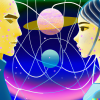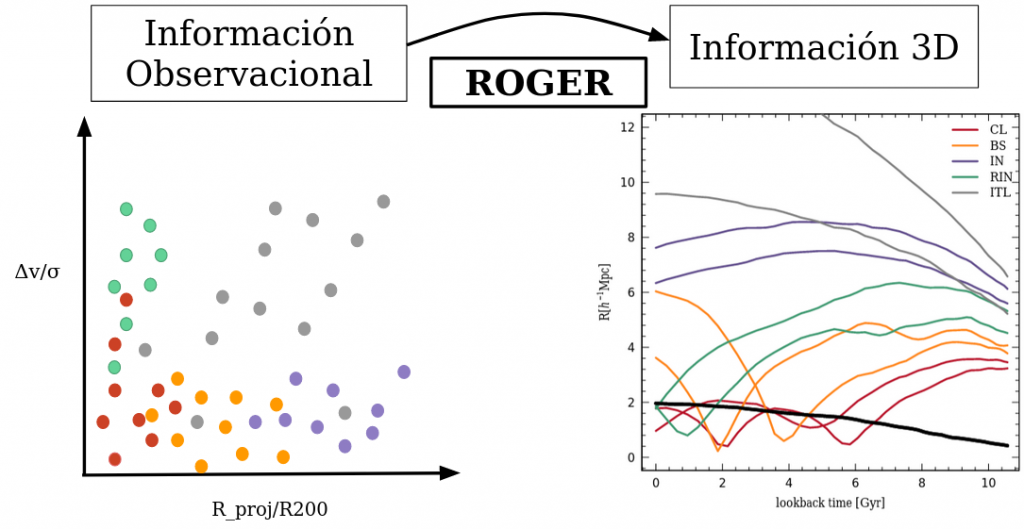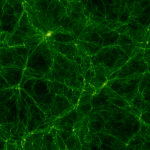Automatic model for the generation of eclipsing binary system catalogues
En el proceso, extrajimos características de las curvas de luz con feets (feATURES eXTRACTOR for tIME sERIES, Cabral et al. 2018) añadimos el cálculo de la diferencia de amplitud entre mínimos y los diferentes periodos. Después mediante MUTUAL INFORMATION generamos una lista de puntuaciones para 35 características, la puntuación depende de la correlación entre las características de las curvas de luz y las clases de EBs.
Finally, we use 3 models (M1, M2 and M3). These models are composed of decision tree (DT), random forest (RF), k-nearest neighbour (KNN) and linear support vector classification (LSVC), plus a voting system. Classification is performed using a composite decision tree. First, M1 classifies BS C and D. Then, depending on the result, M2 classifies BS D and SD or M3 classifies BS C and SD. In Automated classification of eclipsing binary systems in the VVV Survey the outline of the process for determining the best model for the classification of BEs is shown in detail. And in the repository of the vanedaza/CDTIn addition to a notebook for the use of the CDT model we include notebooks for data curation and pre-processing, feature generation, and a notebook is used to generate a report in .tex format containing the light curves of the eclipsing binary systems and a table with information about the system and the classification. |
|
MeSsI (Merging Systems Identification)de los rios+16 2016MNRAS.458..226D Merging galaxy systems provides observational evidence of the existence of dark matter and constraints on its properties. Therefore, statistical uniform samples of merging systems would be a powerful tool for several studies. In this work, we present MeSsI (Merging Systems Identification algorithm) a new machine learning method for merging systems identification. We use as a starting point a mock catalog of galaxy systems, identified using traditional FoF algorithms, which experienced a major merger as indicated by its merger tree. This code is completely free and public and can be downloaded and used as an R package (https://github.com/Martindelosrios/MeSsI). This project was developed by Martín de los Rios, Mariano Domínguez, Dante Paz and Manuel Merchán. |
Fargo 3D
|
|
More information: feets |




 We present the Compound Decision Tree (CDT), an automatic tool for the generation of catalogues of eclipsing binary systems (EBs). This supervised machine learning model is part of a pipeline that has as input time series of EBs and as output the classification of these systems into Detached, Semi-detached and Contact. The training of the model and its evaluation was performed using a catalogue of 100 EBs from the VISTA Variables in the Vía Láctea Survey (VVV) Survey, using tile d040. The performance of CDT to generate catalogues in other tiles was tested on tile d078, obtaining a good classification performance in the three types of EBs compared to the classification performed visually.
We present the Compound Decision Tree (CDT), an automatic tool for the generation of catalogues of eclipsing binary systems (EBs). This supervised machine learning model is part of a pipeline that has as input time series of EBs and as output the classification of these systems into Detached, Semi-detached and Contact. The training of the model and its evaluation was performed using a catalogue of 100 EBs from the VISTA Variables in the Vía Láctea Survey (VVV) Survey, using tile d040. The performance of CDT to generate catalogues in other tiles was tested on tile d078, obtaining a good classification performance in the three types of EBs compared to the classification performed visually.
 ROGER: Reconstructing Orbits of Galaxies in ExtremeRegions using machine learning techniques
ROGER: Reconstructing Orbits of Galaxies in ExtremeRegions using machine learning techniques






